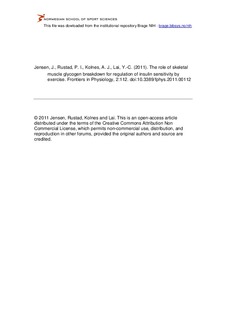| dc.contributor.author | Jensen, Jørgen | |
| dc.contributor.author | Rustad, Per Inge | |
| dc.contributor.author | Kolnes, Anders Jensen | |
| dc.contributor.author | Lai, Yu-Chiang | |
| dc.date.accessioned | 2012-08-31T10:59:29Z | |
| dc.date.available | 2012-08-31T10:59:29Z | |
| dc.date.issued | 2011-12-30 | |
| dc.identifier | Seksjon for fysisk prestasjonsevne / Department of Physical Performance | |
| dc.identifier.citation | Frontiers in Physiology. 2011, 2:112 | no_NO |
| dc.identifier.issn | 1664-042X | |
| dc.identifier.uri | http://hdl.handle.net/11250/170737 | |
| dc.description | © 2011 Jensen, Rustad, Kolnes and Lai. This is an open-access article distributed under the terms of the Creative Commons Attribution Non Commercial License, which permits non-commercial use, distribution, and reproduction in other forums, provided the original authors and source are credited. | no_NO |
| dc.description.abstract | Glycogen is the storage form of carbohydrates in mammals. In humans the majority of glycogen is stored in skeletal muscles (∼500 g) and the liver (∼100 g). Food is supplied in larger meals, but the blood glucose concentration has to be kept within narrow limits to survive and stay healthy. Therefore, the body has to cope with periods of excess carbohydrates and periods without supplementation. Healthy persons remove blood glucose rapidly when glucose is in excess, but insulin-stimulated glucose disposal is reduced in insulin resistant and type 2 diabetic subjects. During a hyperinsulinemic euglycemic clamp, 70–90% of glucose disposal will be stored as muscle glycogen in healthy subjects. The glycogen stores in skeletal muscles are limited because an efficient feedback-mediated inhibition of glycogen synthase prevents accumulation. De novo lipid synthesis can contribute to glucose disposal when glycogen stores are filled. Exercise physiologists normally consider glycogen’s main function as energy substrate. Glycogen is the main energy substrate during exercise intensity above 70% of maximal oxygen uptake (yes) and fatigue develops when the glycogen stores are depleted in the active muscles. After exercise, the rate of glycogen synthesis is increased to replete glycogen stores, and blood glucose is the substrate. Indeed insulin-stimulated glucose uptake and glycogen synthesis is elevated after exercise, which, from an evolutional point of view, will favor glycogen repletion and preparation for new “fight or flight” events. In the modern society, the reduced glycogen stores in skeletal muscles after exercise allows carbohydrates to be stored as muscle glycogen and prevents that glucose is channeled to de novo lipid synthesis, which over time will causes ectopic fat accumulation and insulin resistance. The reduction of skeletal muscle glycogen after exercise allows a healthy storage of carbohydrates after meals and prevents development of type 2 diabetes. | no_NO |
| dc.language.iso | eng | no_NO |
| dc.publisher | frontiers.org | no_NO |
| dc.subject | glycogen phosphorylase | no_NO |
| dc.subject | glycogen synthase | no_NO |
| dc.subject | exercise | no_NO |
| dc.subject | type 2 diabetes | no_NO |
| dc.subject | insulin resistance | no_NO |
| dc.subject | de novo lipogenesis | no_NO |
| dc.title | The role of skeletal muscle glycogen breakdown for regulation of insulin sensitivity by exercise | no_NO |
| dc.type | Journal article | no_NO |
| dc.type | Peer reviewed | no_NO |
| dc.subject.nsi | VDP::Medical disciplines: 700::Basic medical, dental and veterinary science disciplines: 710 | no_NO |
| dc.source.volume | 2 | no_NO |
| dc.source.journal | Frontiers in Physiology | no_NO |
